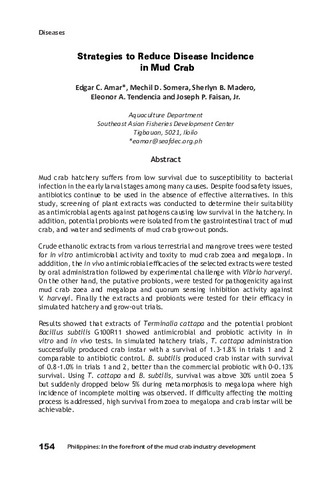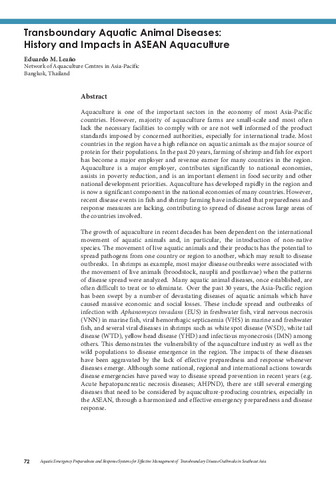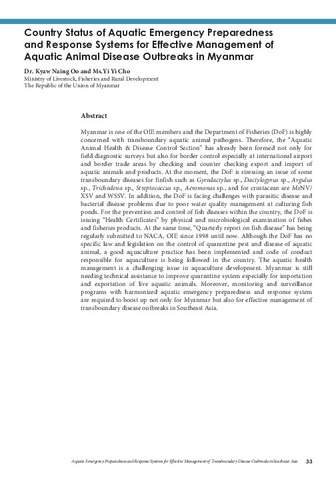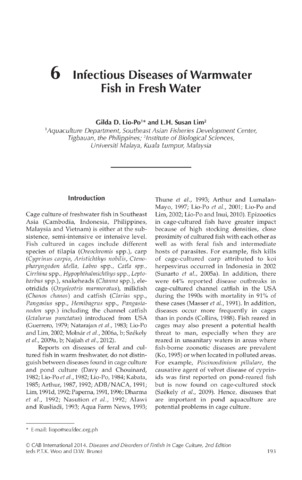Strategies to reduce disease incidence in mud crab culture
Share
Abstract
Mud crab hatchery suffers from low survival due to susceptibility to bacterial infection in the early larval stages among many causes. Despite food safety issues, antibiotics continue to be used in the absence of effective alternatives. In this study, screening of plant extracts was conducted to determine their suitability as antimicrobial agents against pathogens causing low survival in the hatchery. In addition, potential probionts were isolated from the gastrointestinal tract of mud crab, and water and sediments of mud crab grow-out ponds.Crude ethanolic extracts from various terrestrial and mangrove trees were tested for in vitro antimicrobial activity and toxicity to mud crab zoea and megalopa. In addition, the in vivo antimicrobial efficacies of the selected extracts were tested by oral administration followed by experimental challenge with Vibrio harveryi. On the other hand, the putative probionts, were tested for pathogenicity against mud crab zoea and megalopa and quorum sensing inhibition activity against V. harveyi. Finally the extracts and probionts were tested for their efficacy in simulated hatchery and grow-out trials.Results showed that extracts of Terminalia cattapa and the potential probiont Bacillus subtilis G100R11 showed antimicrobial and probiotic activity in in vitro and in vivo tests. In simulated hatchery trials, T. cattapa administration successfully produced crab instar with a survival of 1.3-1.8% in trials 1 and 2 comparable to antibiotic control. B. subtilis produced crab instar with survival of 0.8-1.0% in trials 1 and 2, better than the commercial probiotic with 0-0.13% survival. Using T. cattapa and B. subtilis, survival was above 30% until zoea 5 but suddenly dropped below 5% during metamorphosis to megalopa where high incidence of incomplete molting was observed. If difficulty affecting the molting process is addressed, high survival from zoea to megalopa and crab instar will be achievable.
Description
Abstract only.
Suggested Citation
Amar, E. C., Somera, M. D., Madero, S. B., Tendencia, E. A., & Faisan Jr., J. P. (2017). Strategies to reduce disease incidence in mud crab culture. In E. T. Quinitio, F. D. Parado-Estepa, & R. M. Coloso (Eds.), Philippines : In the forefront of the mud crab industry development : proceedings of the 1st National Mud Crab Congress, 16-18 November 2015, Iloilo City, Philippines (p. 154). Tigbauan, Iloilo, Philippines: Aquaculture Department, Southeast Asian Fisheries Development Center.
Subject
antibiotics  ; bacterial diseases
; bacterial diseases  ; bioactive compounds
; bioactive compounds  ; crab culture
; crab culture  ; developmental stages
; developmental stages  ; disease control
; disease control  ; growing ponds
; growing ponds  ; hatcheries; husbandry diseases; larvae
; hatcheries; husbandry diseases; larvae  ; marine crustaceans
; marine crustaceans  ; metamorphosis
; metamorphosis  ; mortality
; mortality  ; moulting
; moulting  ; pond culture
; pond culture  ; probiotics
; probiotics  ; disease prophylaxis
; disease prophylaxis  ; survival
; survival  ; therapy
; therapy  ; zoeae
; zoeae  ; Scylla
; Scylla  ; Philippines
; Philippines 
 ; bacterial diseases
; bacterial diseases  ; bioactive compounds
; bioactive compounds  ; crab culture
; crab culture  ; developmental stages
; developmental stages  ; disease control
; disease control  ; growing ponds
; growing ponds  ; hatcheries; husbandry diseases; larvae
; hatcheries; husbandry diseases; larvae  ; marine crustaceans
; marine crustaceans  ; metamorphosis
; metamorphosis  ; mortality
; mortality  ; moulting
; moulting  ; pond culture
; pond culture  ; probiotics
; probiotics  ; disease prophylaxis
; disease prophylaxis  ; survival
; survival  ; therapy
; therapy  ; zoeae
; zoeae  ; Scylla
; Scylla  ; Philippines
; Philippines 
Taxonomic term
Related items
Showing items related by title, author, creator and subject.
-
Transboundary aquatic animal diseases: History and impacts in ASEAN aquaculture
Leaño, Eduardo M. (Aquaculture Department, Southeast Asian Fisheries Development Center, 2019)Aquaculture is one of the important sectors in the economy of most Asia-Pacific countries. However, majority of aquaculture farms are small-scale and most often lack the necessary facilities to comply with or are not well ... -
Country status of aquatic emergency preparedness and response systems for effective management of aquatic animal disease outbreaks in Myanmar
Oo, Kyaw Naing; Cho, Yi Yi (Aquaculture Department, Southeast Asian Fisheries Development Center, 2019)Myanmar is one of the OIE members and the Department of Fisheries (DoF) is highly concerned with transboundary aquatic animal pathogens. Therefore, the Aquatic Animal Health & Disease Control Section has already been ... -
Infectious diseases of warmwater fish in fresh water
Lio-Po, Gilda D.; Lim, L. H. Susan (CABI Publishing, 2014)This chapter presents the viral, bacterial, pseudofungal and parasitic diseases in cultured warm freshwater fish. Focus is given on the distribution, causative agent, pathology, diagnosis, prevention and control of these diseases.





